Offshore wind farm construction - more pictures
Posted by Jerome a Paris on March 8, 2010 - 10:10am
After showing you pictures of offshore wind turbine foundations in this story, I am pleased to be able to now post pictures of the above-the-water parts, before their installation at sea:
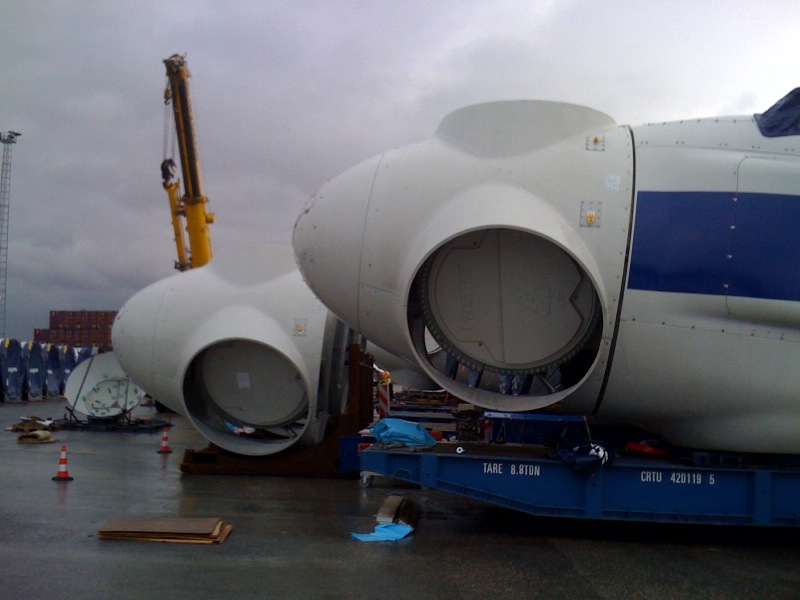
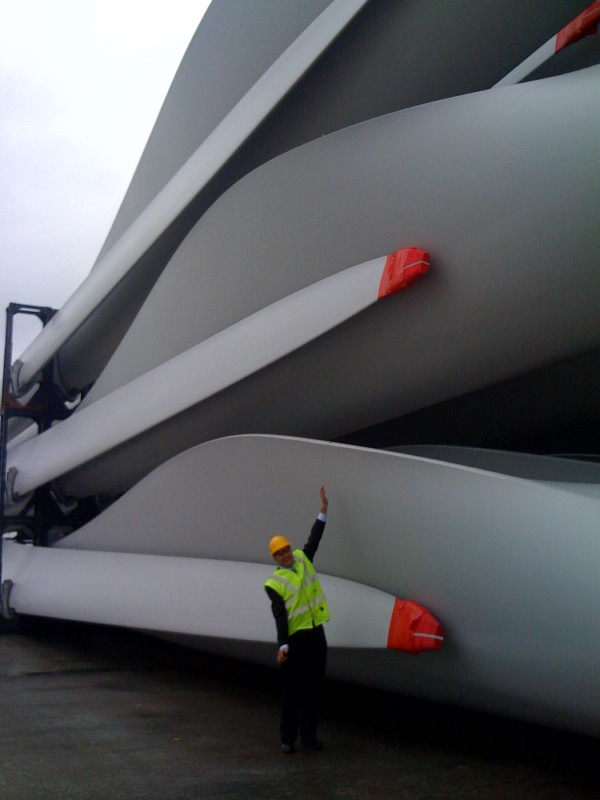
Left: nacelles with the hubs being installed
Right: blades (45m long) stacked
Part of the Wind power series. More below:
If you remember, there were ovality issues with one foundation last time round - well, that was solved and that foundation has now been corrected and installed at sea. The foundation site has just one big item remaining:
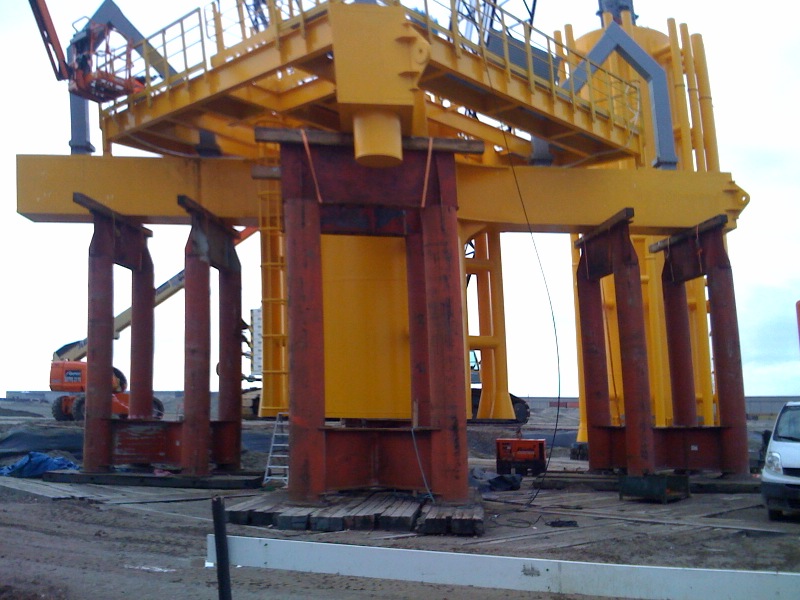
the transition piece for the offshore high voltage transformer station
This transition piece is heavier than the others, and required a re-fit of the jackup barge to be installed. That refit was being done when we visited:

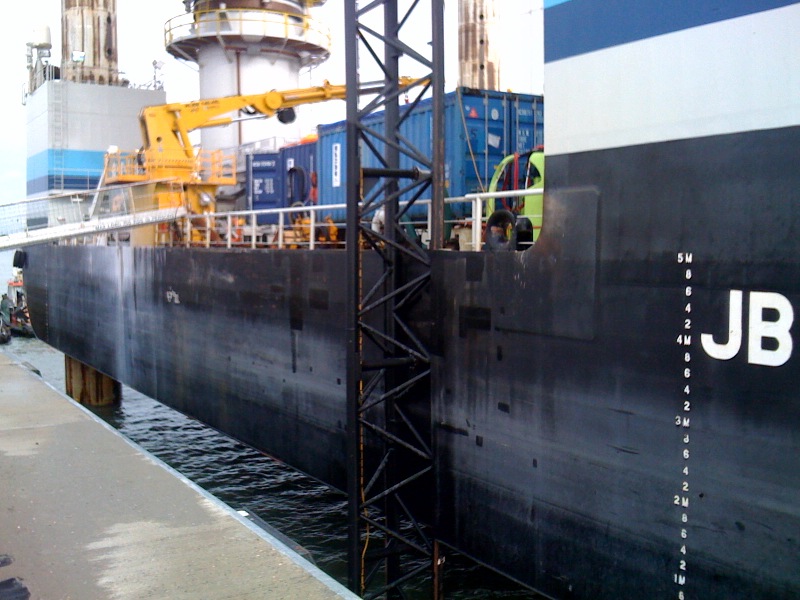
Left: two of the legs that go down in water to lift the platform above the water when it needs to work
Right: the jackup is in the "raised" position in order for the re-fit work to be done in perfectly stable conditions, even in the port
After installing the foundation for the transformer, the vessel will be refitted a second time to begin in a few weeks' time the installation of the towers and turbines, which are arriving at a nearby site:

the nacelles (Vestas V90 - 3MW)
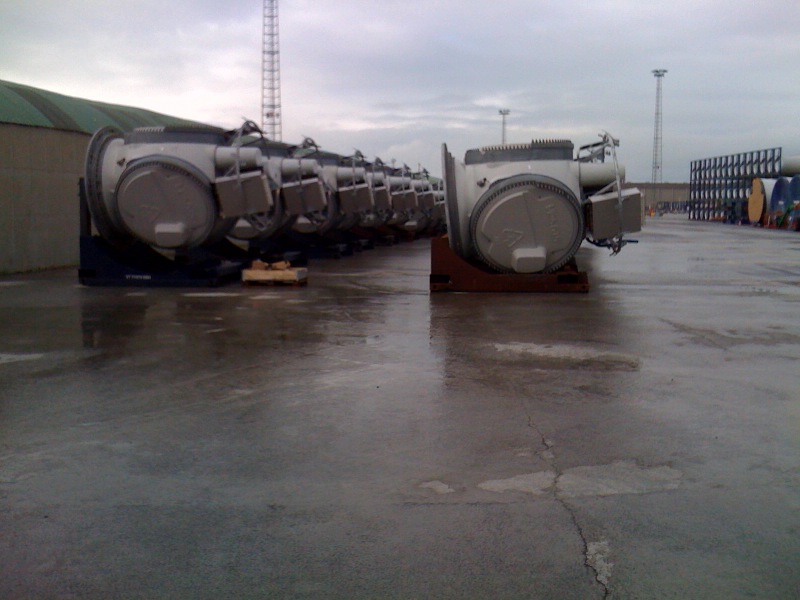

the hubs
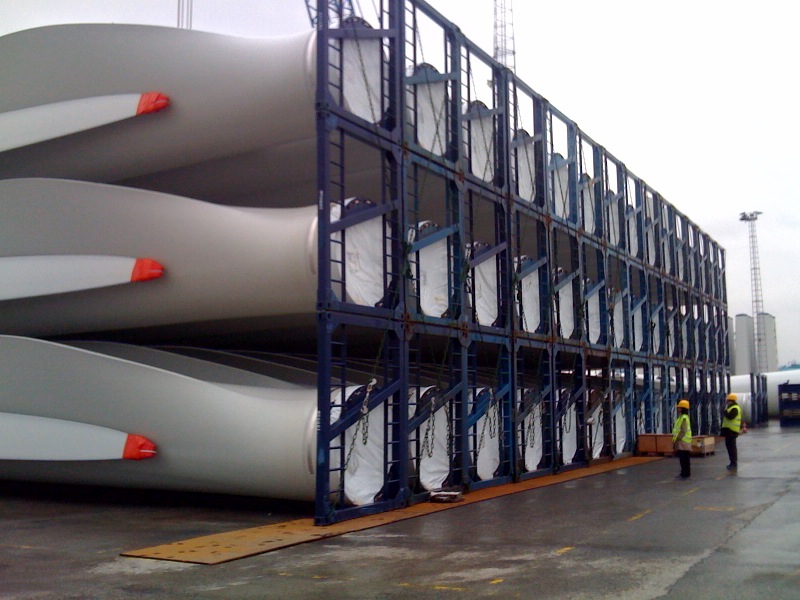

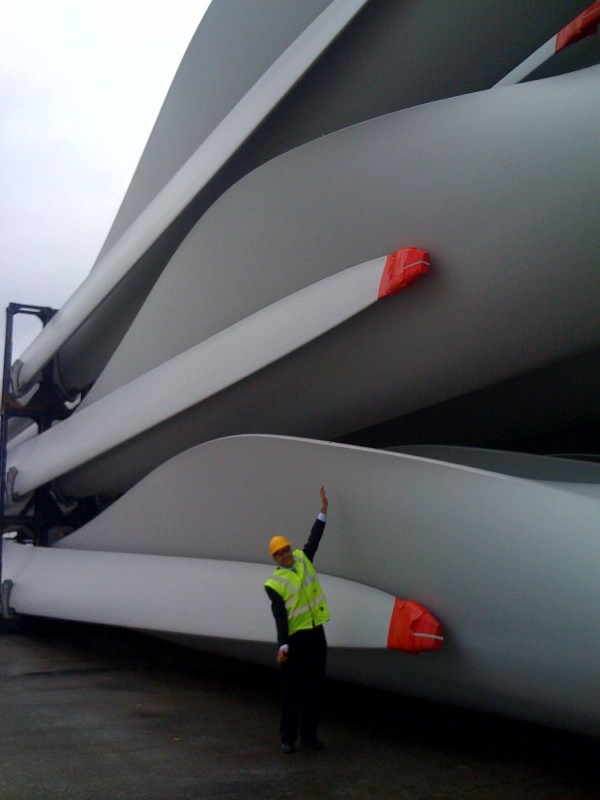
the blades

the first part of the tower
The installation method chosen for this project is to install the turbines with the hub (but not the blades) on top of the towers (which are brought in two parts and are assembled on site) onshore, and transport the full unit to the site at sea in one piece, in a vertical position. Thus, other than the installation of that unit on top of the foundations, the only work offshore will be the installation of the blades, one by one, on the hub.
On the port site, various bits of assembly are happening now: the towers are being erected:

The fully erected towers stand at above 100 meters
The hubs are being attached to the nacelles:
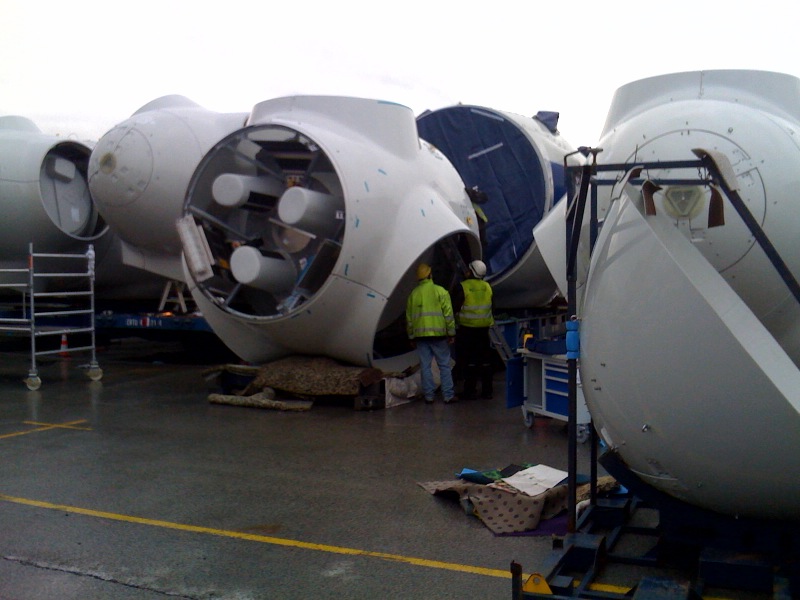
The hubs are first positioned alongside the nacelles
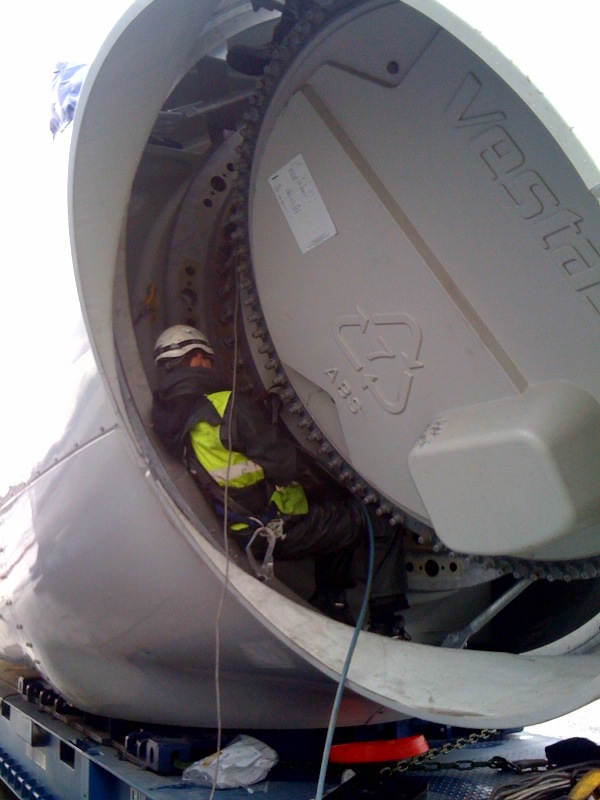
after having being raised into position (something I did not witness), the hubs are bolted to the nacelle
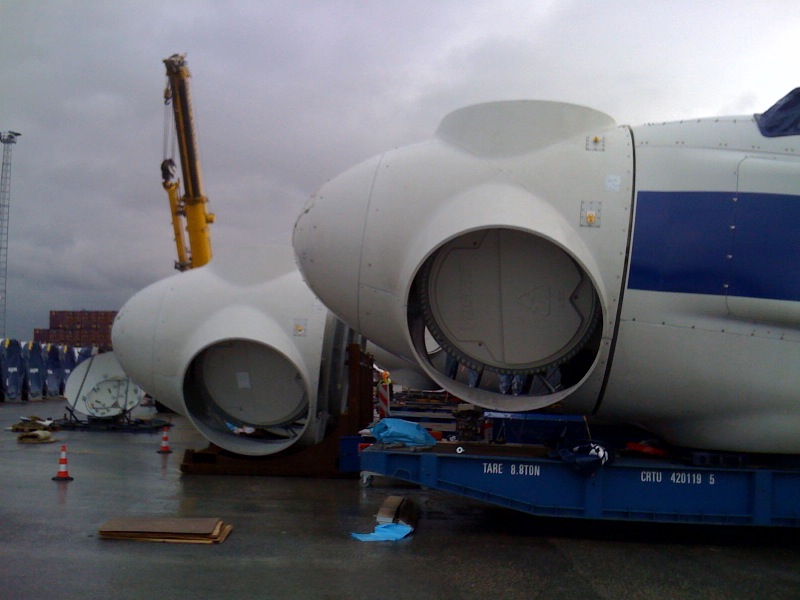
a complete nacelle + hub set in front, with one to be installed behind it
I hope to be able to post more installments in the future - but joining the installation work at sea is usually more difficult as the safety requirements are absolutely stringent and the boats can be mobilised for more than a few days... to be continued.




These turbines seem massive. How do companies plan to handle maintenance? It seems like I have heard about having space for maintenance teams to live on site. I suppose that for really big repairs, they would need assistance of big equipment bought in by ship or helicopter.
They are quite large indeed (although the model shown here, a 3MW turbine, is not by far the largest to be used offshore) and will required specific equipment for maintenance, IF heavy maintenance is required.
1) A lot of work has gone into their design to ensure maximum redundancy of equipment so that (inevitable) small failures do not immediately cause production to stop - this allows repairs to happen with less frequency;
2) a lot of efforts has also gone to ensure that the turbines are modular, and if equipment needs to be replaced, only relatively small pieces of kit need to be transported - this makes it possible to do more maintenance via smaller boats (or helicopters) and using the built-in crane inside the turbine (which can typically carry equipment up to one ton);
3) only large maintenance (replacement of a blade, gear-box or the like) requires a large vessel (lack-up + big crane) and these turbines, plus the long term maintenance strategy, are designed to minimize the requirement for these (and part of my job is indeed to assess whether it is the case, as this has a big impact on both long term O&M costs and actual revenue generation).
Hardware is typically smallish boats (carrying O&M personnel and their toolkit, plus smallish pieces of equipment) - the main requirements there are speed, stability in various wave conditions, and safety; and a larger vessel - usually a jack-up with a big crane, which will be available for a estimated number of interventions per year (and as more wind farm are installed, it will be easier to share out such vessels over a big number of projects, and reduce their cost). Helicopters can be a solution for small interventions when the wind farms are far from shore (the time gain must be worth the slightly higher cost than a boat); living quarter at sea are also being considered for the wind farms (especially in he German sector) which are oo far from the coast to justify boat trips for each maintenance interventions (early wind farms were a few kilometers from the shore; recent ones have been in the 15-40km range, where a boat trip within a day still makes sense; future ones may be more than a 100km offshore, with completely different logistics).
The O&M cost is estimated to be around 2c/kWh.
See the Vestas V90 media kit:
http://nozebra.ipapercms.dk/Vestas/Communication/MediaKit/UK/VestasMedia...
They claim an energy (electricity) payback time of less than 7 months.
More on the V90 series:
http://www.vestas.com/en/wind-power-solutions/wind-turbines/2.0-mw.aspx
MITs report on V90 reliability's effect on output:
http://web.mit.edu/foley/Public/SimAbstract.pdf
The V90 has had issues:
http://www.emerging-energy.com/user/category_docs.aspx?l1=&catid=GlobalW...
Watch out; That 7 month payback refers to the amount of energy used to manufacture the wind turbine against the energy it generates in that time.
It is not a £/$ payback on the investment into the wind turbine.
It would be good to see some data on this as Vestas is a market leader. Nice to see investment on a range of sites and the electricity generated, and compared to the plate capacity.
There are so many variables (site, price/kwh, reliability issues, etc.) each project would have to be audited over time. Wind advocates often include energy payback upfront since there has been so much misinformation put out on this aspect of wind power. We've seen the same tactic used on PV (ie: solar panels can never produce enough energy to offset the energy used to produce them).
There is alot of analysis ongoing:
Requires registration to get to the meat and potatos:
http://www.emerging-energy.com/user/USWindPowerMarketsandStrategies20092...
Some detailed report on wind power onshore/ofshore
http://www.olino.org/us/wp-content/uploads/2009/06/economics_of_wind_mai...
Impressive pictures! I love to do some work in that area!
What about the energy required to build and maintain the grid for them?
The "payback" has to include all the energy or cost for the entire system to get it to the end users.
This EROEI is way more complicated than most people realize and even includes recursive loops and all the energy from the point of resource extraction for materials.
I suspect that if ever it is possible to account for all energy that we might find that the EROEI might be much less than first assumed.
Only time will bear my hunch out though.
I think the incredible gift of petroleum in it's very dense and easy to get package is way underestimated relative to these substitutes...........maybe not by people here but in general.
To be fair you'd have to do that for all other forms as well -- once you get to the grid the rest is common regardless of the source. Hydroelectric dams often have many miles of transmission lines to get to a grid as well.
It is clear, though, that EROEI is significantly positive for wind. We're past the early trials of technology and are solidly into scaling and innovation phases. Not quite to the commodity product and mature support industry, though. I have yet to see used turbines in equipment yards like I see pumpjacks and drilling rigs.
I agree with many of the posts. Impressive pictures and a good insight into into the practicalities of how these things that we see more and more of (as we criss-cross the North Sea/European coasts en route to anywhere) were built. I too spent time on offshore rigs (anyone remember the Ekofisk jackup program back in the 80s?) and it has been a great testing ground for much of the practicalities and realities of these installations. It seems we are getting enough scale and density of operation in place to ensure a viable service sector to support existing and new projects. Interesting times.
Those pictures can't be real. We all know wind isn't economically viable without massive subsidies.
It also takes humongous amounts of energy, hundreds of highly trained specialists and and all kinds of ginourmous machines brought in by gigantic ships and helicopters to maintain them. Nope, no way can these pictures be real ;-)
Now, off shore oil rigs, those are quite cheap and easy to maintain...at least the little ones are.
I'm sure for many the pics seem very impressive. But in the world of offshore oil/NG production ops they are just a little more than tinker toys. In the GOM these would be classified as MOS...Minimum Offshore Structures. A couple of years ago Texas awarded windfarm leases for tracts is state waters. No word yet on development plans but with the current slack in the oil patch costs should be at their lowest point in a while. We have dozens of idle construction yards that would be very happy to take on such contracts.
Despite the fact that I have actually worked on offshore oil rigs I still find them impressive but as you mention if we compare them to "offshore oil/NG production ops they are just a little more than tinker toys."
But, impressive tinker toys, nonetheless!
I agree FM. Like me you probably find them "cute". Back in the 90's I dealt with a lot of MOS's and it was nice to not have to deal with the expense of conventional platforms on marginal properties. At this point it would seem offshore windfarms fall into such a marginal category. With the new MMS regs I'm not sure what we can get away with today. That jacket did look kinda light for the N Sea but I'm sure they know the required specs. Since ours are state water leases water depth should be no more than 100' at worse.
Now look at this toy - The Troll A Condeep Platform -
- The Troll Platform while being towed from the fjords .... ..... has an overall height of 472m or 1 548 feet
It is the heaviest, tallest and obviously largest object ever moved by man. It's providing the largest chunk of Norwegian nat.gas for Europe.
Can't imagine how they could possibly maintain such a structure without magic or something like it ;-)
As much as I think that BAU will not continue for much longer I can't help but but be impressed with everything that went into building that structure and putting it in place for production. It also has to make you sit up and take notice of what our current lifestyles really cost. IMHO a few LED's and solar panels ain't what is going to break us in the end...
Just a bit curious about the name "Troll" does that mean something different in Norwegian?
I'm still freshly impressed by that construction - as if I saw it first time yesterday.
Norwegian (Scandinavian) Trolls are mythical creatures from folklore who live in the forest/mountains and is seldom observed (of course) because they'll explode and die if they look at the sun. They come in various shapes and forms and is the Norse parallel to "Giants" or so.
Impressive indeed, we are moving some big stuff--but for perspective and a dose of humility, this is what a little 9.3 centered off Alaska moved on Good Friday 1964.
taken from this USGS site.
Now that is moving stuff big time.
On a more related note, it does seem there was a bit of a learning curve for building condeep structures. This links part of a report on the one that imploded during construction in 1991. Tricky engineering. Being familiar with the typical overbuild of land based concrete foundations I can only begin to appreciate what building one of these condeeps entails.
Those platforms are amazing! All you have to do is look at one to get an idea of why oil is becoming so much more expensive. This week's Economist mag has a good story about the progression of oil platform design and all of the seismic work that has to be done to find oil at depths. http://www.economist.com/daily/chartgallery/displaystory.cfm?story_id=15...
Well, we're entering "serious" territory size-wise and budget-wise. This project has a budget of close to a billion dollars (above 600M euros) and several others beign built now in the 300-500MW range above budgets in the 1-2 billion euro range.
Ultimately, the wind structures offshore, while big, are indeed smaller than oil platforms, but the requirement to life a few hundred tons to 100 meters height with only 1 cm tolerance in where you bring it, with your "legs" in the water, are quite impressive too!
Jerome, To be clear I am duly impressed by the scale, the precision engineering and the magnitude of the budget, not to mention that I take my hat off to you for being able to orchestrate these deals.
My original comment is somewhat tongue in cheek and is intended as a good natured dig at the folks who seem to be missing a proper sense of perspective when discussing this kind of technology as being "so massive".
Yeah, the Rockies are a most impressive mountain range but if you've seen the Himalayas and have climbed Mount Everest you might want to save the superlatives for the latter.
BTW once you've actually lived and worked on an oil rig even they become rather small and cramped.
Take it from someone who used to run laps around the heliport and was tasked with swimming underneath one. Kinda cool to look up ;-)
Jerome-
As a former commercial fisherman, I regularly dealt with salt water and engines, electronics, etc.
I was a continuous battle, with the salt water always on the offensive.
What is the maintenance required?
Impressive (and I have been on Oil Platforms off Santa Barbara).
Yes, they may be small relative to massive oil platforms. However, those oil platforms lack massive external moving parts. Having huge dynamic rotor greatly changes the mechanics of the situation.
Actually lawyer some of those platforms/mobile drilling rigs have internal machines many times the size of those rotors. One of the biggest engineering challenges in the offshore are the massive NG compressors. The vibration mechanics alone are quit involved. Such systems might be 10X the mass of a single rotor. In case some missed my subtle point: offshore windfarms, while truly impressive engineering projects, don't require a new engineering forefront. IOW, developing offshore windfarms is achievable with current engineering tools. What's needed is the economic incentive and public/political support. I have a bad feeling that the US is falling behind not so much because of economics but lack of political/free enterprise focus. Perhaps more press on the efforts of jerome et al will change that.
Your comment is right on target...though as you have pointed out along the way, capital is also hard to come by these days. Jerome is doing it though and he has financed at least 4 offshore wind projects lately.
ROCKMAN -
Right on!
I've noticed that critics of wind power, both here at TOD and elsewhere, like to latch onto the size of wind turbines and their support structures as 'proof' that wind power will not be doable in a resource-constrained world. I say that is a lot of rubbish.
I have very carefully viewed many videos of wind turbine manufacture and installation. While it is true that these involve some very specialized construction techniques, there is really nothing cutting edge or high-tech about the whole thing. It should also be noted that even a very large wind turbine is not all that heavy in relation to its visual appearance. The blades, in particular, are surprisingly light for their size (as they should be, to reduce dynamic stress and vibrations). There is really nothing all that astounding about lifting an object weighing over 100 tons several hundred feet into the air. This sort of construction technique has been well mastered and is practiced all the time under all sorts of conditions. And yes, an offshore oil platform is several orders of magnitude more complex and difficult to construction, but it is done all the time.
Also, as the design of wind turbines become more standardized, and as more and more operational experience is acquired, we should expect down-time and maintenance costs to be reduced accordingly.
If low-tech is desirable for a resource-constrained world (and that may not necessarily be a universal truth) a wind turbine is many times more low-tech than an equivalent fossil fuel-burning power plant and should be much more easy to build and operate when things get really tough. This is also a good reminder that terms like 'low-tech' and high-tech' are pretty meaningless when used in absolute terms. Something can only be low- or high-tech when compared to something else. As such, a wind turbine is more high-tech than an ox cart, but more low-tech than a nuclear power plant.
Great photos Jerome! This shows you how much offshore wind is just beginning to scale up. There are over 37,000 MW of projects planned throughout europe for 2015.
Last week our Great Lakes Offshore Wind Council sent recommendations for legislative rulemaking to some key legislators and we will begin having public engagement meetings throughout the state later this month. http://www.michiganglowcouncil.org/ Based on our GLOW council report, if only 2% of the areas designated as "most favorable" and "conditional" were to be developed they would supply about 30% of the electrical energy used in Michigan.
Offshore wind has huge potential and it will be interesting to watch this rapidly ramp up over the next few years.
See also ONTARIOʼS OFFSHORE WIND POTENTIAL A QUARTER OF A TRILLION DOLLAR OPPORTUNITY SAYS TRILLIUM POWER WIND CORPORATION about the Canadian side of the Great Lakes.
same as above.
Love the pictures - keep em coming!
Looks like some seriously impressive engineering has gone into these puppies!
...see! Humans aren't so dumb after all!
Dumb is relative. I bet there's something in this universe, without opposible thumbs, that makes us look like morons. Maybe even something on earth, the way we're going.
Holy smokes . . . those are just 3MW? By what I understand, they are now working on 10MW models . . . those must be gargantuan.
I wonder why my state of California hasn't been doing more offshore wind? A problem utilities often have with renewable sites is the routing of power lines . . . but with offshore, there should not be much of an issue since the power lines just run along the bottom of the ocean (I assume).
If there is one thing that I REALLY hate is NIMBYism against windmills. OK, perhaps not a few hundred yards from your house due to the noise. But the sight of them? Beautiful, IMHO. I'd like to site a coal plant in the backyard of people that refuse to allow windmills.
Around the Golden Gate bridge is a great place for windmills as it is a very windy area during hot summer days. I know this as a windsurfer. Since that coincides with peak demand, I wonder why they have not been installed there? NIMBYism? Not consistent enough wind?
Forget the Golden Gate bridge. Put the windmills on Candlestick point. Anyone who has ever attended a baseball game at Candlestick Park knows that the constant hurricane that blows there is enough to power the world!
Most offshore wind farms in Europe are in shallow waters of the North Sea which has a mean depth of 90meter (300 feet). Most wind turbine foundations here are sitting on the bottom or drilled into the sea floor.
The California cost is very different. The ocean floor gets very deap very fast off the cost. Too deap for the wind turbine foundations used in Europe. The Golden Gate itself has a depth of 400ft. A wind farm off the california coast would require floating foundations. This type of foundation for wind turbins is still in development. An experimental design was deployed off the Norway coast late last year.
http://en.wikipedia.org/wiki/Floating_wind_turbine
Most impressive.
I'm guessing the blades are composite but the platform and tower are steel? I'm curious what sort of maintenance has to be done (and how often) to fight off the effects of corrosion. I cringe to think of the salt water reducing all that precision engineering to rust. Is it a special grade of steel, or even stainless, and what is it coated with?
Koy -- To continue as I have been popping in and out, this is also another non-problem. True, rust never sleeps. But such prblems have been dealt with by the oil patch for over 50 years. Cathodic protection against corrosion is a science unto itself. Likewise with steel composition/coatings. That's the point I keep coming back to: offshore wind farm development doesn't require a new engineering frame work. Essentially all the "what if" problems have been addressed for many decades. Probably the single biggest issue remaining would be protecting the towers from hurricane force winds. But just like offshore oil platforms, you can only protect such structures to a degree. After that you have insurance only to protect your investment. No offshore structures are built to withstand "worse case" scenarios. For that matter, neither are onshore facilities.
Cathodic protection and hi-tech coatings stop the rust, but add expense and don't last for ever.
The problem with transferring technology from Ekofisk, Forties, and Troll to an offshore windfarm is that the revenue stream from the latter is tiny in comparison to the former. Offshore wind power only has a long-term future if the cost base can be driven far below what is typical in the oil patch. Oil patch technology may have been OK as a starting point, but a lot of it needs serious rethinking to make offshore wind economic.
We design our offshore platforms for 100-year storms with usual safety factors, and for 10000-year storms without safety factors, which surely qualifies as a "worse case" scenario! Indeed this is one of the areas for possible cost reduction in offshore wind turbines. Since no-one is on board and at risk during a storm, we should simply balance the cost of collapse times the probability of collapse against the overdesign cost to prevent collapse. I haven't seen any authoritative comparison figures, but 10000 years is probably way beyond the economic optimum.
We could probably learn a few lessons from GOM platforms, which aren't designed for a 10000-year storm because they can be shut-down and evacuated in advance; though the storm spectrum is radically different of course.
All so true Scotty. That's why I wonder what the real economic value might be. Cost estimates are always wrong and almost always low. But they should be close enough to develop a nominal sales price needed to make these projects work. Makes me also wonder if the folks cooking the numbers will use decommish costs in their analysis. I've seen more than one offshore oil/NG project lose much of its present value when such a factor is frint loaded. As you imply: nothing last for ever. And sometime it can cost more to remove a structure from the water then to put it in place.
And they did lern a few lessons in the GOM: the Feds upped the structural requirements. Still not N Sea standards but better.
I agree that renewable energy is - sadly! - not immune from the number-cooking brigade, and decommissioning costs may well be fudged. But I'm surprised you've come across offshore oil/NG projects where decom has really hit the NPV badly. The oil patch works on an average discount rate of 15%, and an offshore project generally lasts >10 years, so decom costs should be discounted by >80%. (In the few cases where we've decommissioned offshore projects in <10 years, it was to retrieve an FPSO for better use elsewhere - Durward/Dauntless, Leadon, Emerald...)
Decom costs may not matter much for wind farms, because wind - unlike oil - doesn't deplete, so decommissioning is only needed once the facility becomes hopelessly obsolete or unsafe. Though I suspect that wind farm developers use a lower discount rate than 15%.
Scotty -- Just caught a couple of odd circumstances. One included a $23 million estimate for just the jacket removal. But remaining reserves were only worth $20 million. But that one ended up being to our benefit. After everyone turned away from the deal the gov't changed the rules and we were able to just take the top 100' off and leave the rest. That only cost $4 million. For a while P&A + decomish got very expensive in the GOM.
One other difference between oil and wind when decommissioning. The oil site will not be used again, whereas the first developed wind sites likely will still be among the best available come decommissioning time--barring major weather pattern and sea depth changes that is. But such consideration is far down the road and probably will have no bearing whatsoever on the current discount rate offshore wind developers use.
I don't see decom costs as a factor. If the foundation is sound, swap the old unit out for a new model. If not, remove the recylables and a few gallons of anfo will do the rest. Instant reef. As long as there are no toxicity/environmental issues, the fish will love it. The salvage value of the copper and neodymium will offset costs some as well.
You are probably right but if the windmills get put in real thick and the same sites are the best ones to use again, we probably want to keep the area navigable, so probably no reefs its fairly shallow sites. But then in shallower water getting the bulk of the above sea floor foundation out won't be as difficult.
My guess is that you will repower at least once which will take the wind farm life out to at least 50 years. At even a 10% discount rate the decommissioning costs should be relatively minor.
I can just imagine WW11. Couple of Spitfires or ME109's stitching them full of holes.....Wonder what the symbol on the sides of the planes denoting kills would look like.
Would the protection against them be like a 10000 year storm?
EDIT:This place has some interesting facts, apologies if previously posted.
http://www.metaefficient.com/news/new-record-worlds-largest-wind-turbine...
Though I have modest expectations for alternative energy, I do love these offshore, oversized tinker toys. Just like oil rigs, and oil derricks (grasshoppers), they seem to have a personality.
There is a wind farm on the way to Palm Springs where I live.
Doesn't quite light up Los Angeles, barely lights up Palm Springs, but it's kind of cute.
I also like solar concentrators. You don't have to worry about depletion of rare minerals, like thin film solar, it seems simpler than PVs, and it almost feels like a modern version of Stonehenge.
Silicon thinfilm PV doesn't worry about depletion of rare materials either.
And a photovoltaic-cell is basically a simple diode, has no moving parts, makes no noise, produces power only during daytime when electricity consumption is more than doubled and since it produces power on ones roof, it reduces the load on the grid and doesn't not have to compete at wholesale price-level.
(A PV system on ones roof will typically be way more effective than a small wind turbine on that same roof.)
I don't really have a problem with silicon PV, other than the fact that sunlight is difffuse and I don't think it will save the world and I worry about it's price tag.
but...,
I do have have issues with thin film solar like CdTe, and CuInSe2..., because I worry about the availablility of Indium and or, eventually, Selenium.
These minerals will also follow Hubbert curves of their own.
As for it's simplicity..., I was thiniking not just about a nice looking solar cell that generates electricity, but the manufacture of this stuff. I don't know how simple it may or may not be..., I just assumed that Solar thermal energy is simpler to design than solar PV.
I know I should not have assumed anything.
Besides the fact that no single option will save the world, but a combination of many different options will.
The AIG bailout cost $180 billion: Enough to finance highly automated silicon thinfilm factories capable to produce 960 GW in only 10 years.
(A 160 MW factory costs less than $0.3 billion:
http://www.oerlikon.com/ecomaXL/index.php?site=OERLIKON_EN_archive_2006_... )
Well, for instance here in Europe, the sun projects about 1000kWh of energy per meter squared. An average household has enough roof space to provide a surplus of electricity. Then there are also the factory, commercial and barn roofs that can significantly reduce their owners net energy usage.
Production costs are going down, down, down and new techs like thinfilm, roll-to-roll, inkjet-like print techniques, plastic instead of aluminum carriers etc will be able to drive the price down for a long time. FirstSolar already produces between $0.8 - $1 per Wp using rather conventional silicon chip techniques. SunPower already has commercial PV with 20+% panel efficiencies.
Yes, PV has a bright future.
Enter: Big-eyed Engineer and his steely-eyed pop.
Gosh, pop! Look at the big twucks and pwopellors and stuff. Gee whiz!! We can destroy the planet in how many ways!!
Aw shucks kid, you ain't seen nothin'. We got oil rigs that could eat your little electrical tinker toys for breakfast.
Enter naysayer:
If we get enough of these, we can rest assured that the population will no longer grow, that these machines will last forever, and if they don't, the resources need to build them will last forever, that we will not kill off the rest of the ocean, the rest of the soil, the rest of the air, or the rest of the species.
I cannot understand the mindset I see here. More, more, more is all I hear here. Let's keep business as usual(BAU) alive and well with windmills!
I have news, BAU is killing the planet and every tinker toy you build that continues BAU is a stake in the heart of the earth and the human species.
I bet German engineers marveled at the efficiency of their camps, engineers at Trinity marveled at their gadget, the designers of asbestos insulated steamworks patted each other on the back and handed out cigars, and the tradition continues...look at the marvelous wind machines. They'll keep us in cheese doodles and reality TV for another generation.
Enter Hero Engineer:
Don't listen to that troll Martin, he ain't an engineer and we know what that means: He just doesn't understand our big words and important concepts. He probably wants us to go back to the stone age and stop watching the PGA on television. Let's throw some engineerin' words at him and chase him off. Yup, we don't need no downer like that in the clubhouse. Be gone, you sad sack liberal arts person. Go back to your service sector job and leave the real economy to us.
The Hero Engineer shoves the Naysayer into a specially designed, windmill powered wood chipper (it ain't murder cause the state labeled him a terrorist!! You can tell by the yellow star and moon he has to wear on his clothing).
And the engineerin' boys once again stood with fists on hips, hair blowing in the wind, chin a-jut on top of the natural world which cowered in respect. "That's right folks, we built it, it sucked, we'll fix it, ad infinitum, ad nauseum."
And the curtain closes on the engineer's fantasy.
Must be Miller time.
great story.... must have been written by a liberal arts major.
No wait...this story is true and about marine engineer, Marmiduke Surfaceblow who has a reputation for solving difficult problems throughout the world. http://www.powermag.com/marmaduke/
Don't worry, some of us are already quite convinced that BAU is dead. Wind generated electricity may help power a less energy intense civilization but it most certainly is not going to be enough for what I at least call BAU.
Personally I'm plodding along somewhere on the spectrum of possibilities of reducing my personal carbon footprint and simplifing my life. I try to take into consideration many aspects of my life, from my choices in what I eat, to when riding my bike or paddling my kayak is appropriate.
I'm also working on real world applications to reduce energy consumption such as this solar powered off grid light post that my business partners and I developed and will soon market. see my comment:
http://www.theoildrum.com/node/6276#comment-597322
I may eventually have to go live in a cave somewhere but in the meantime I'm going to try like hell to go down fighting against the darkness with LEDs, solar panels and wind generators ;-)
Oh, just curious, do you know how to make your own beer?
Cheers!
Jeez, FM, you're just BAU lite. Try rubbing two sticks together and you can light your way back to Utopia.
BAU Lite?! Nah, kinda weak ;-)...
Could I perhaps interest you in The New and Improved ExBAU Pro Lite?
Its great for finding the bathroom in the old McMansion when the power company finally shuts off your power.
Nice but seems a bit bulky to me. I kind of like these smaller and more efficient LED lights that you can strap on your head. http://cgi.ebay.com/Magicshine-High-Power-P7-LED-Headlight-Bicycle-Light... They throw out a great light. Very handy if you have to cross country ski to your McMansion.
Yeah, I do like yours better. Check out my LED Solar light post linked above. I can light the entire front yard with it.
I like it. If I had a power company I would order one. Wish I had one back in my spelunking days. I still have my old Petzel, though. Beats rubbing sticks together.
Still got my brass miners lamp from my caving days. Hard to find carbide, but you knew how much light you had left. Batteries always run down when you least expect it.
I think you may be right; that BAU is dead (doing my bit... commuting 'round the burbs on a 150cc motorbike). But I still don't think many of my fellow Joes and Janes think that way; and they're all voters.
No doubt I'm impressed by such projects and experiencing them up close is pretty cool, like seeing a bullet train in action for the first time. But because our leaders (the vote receivers) need BAU for the forseeable future, I wonder about scale and ultimate sustainability of such projects. For starters, we still need large amounts of fossil fuels to dig all that metal out of the ground, right?
Does anyone believe wind turbines will be around (in significant numbers) one or even two hundred years from now?
Or are wind farms just another bridge to the next black swan?
Regards, Matt B
Still a concerned dad
Still with no idea :(
First, you grow some barley....;^)
Really BAU is dead?...Really?....Ok, HOW do you know that?...Or are we talking F-E-E-L-I-N-G-S???
Wind power can't supply enough electricity?....What if you had 2 billion wind farms all over the globe???....Not enough?!??....Ok, how about TEN billion???
Oh!!!...You mean YOU don't know??????
The horror!!!....The horror!!!
You Sir....are a truly sorry specimen of a man....
Well, in my case I just look at things like economic indicators including unemployment numbers, foreclosure rates, number of people without health care, credit card defaults, government bailouts of automobile companies and financial institutions. I also look at empirical data about petroleum reserves and declining rates of discoveries for new oil fields. I also look at the data regarding climate change and ecological devastation all over the globe. I look locally and the watch coral dieing on my local reefs and see the patches of invasive algae and note fewer fish and lobster. I talk to the local turtle rescue group and hear that things have never been worse etc.etc...
Then I have to listen to deluded individuals who ask questions like: "how do you know that BAU is dead?!"
But its OK, I understand that to them what I just described *IS* BAU and will continue to be for ever and ever, Amen!
I may indeed be a "sorry specimen of a man" but I don't think I will be allowed to publicly state on this site what I think you are. Too bad because I am very sorely tempted! And I wouldn't even be the slightest bit sorry about it!
I spent today in the city video-taping big business CEOs talking about double-digit growth as "the goal". And government officials talking about expanding services for the swelling population. Speaker after speaker, on profits and wanting more. And I'm doing the same thing tomorrow.
Damn I wanted to put my hand up. Then again, I'm part of the problem as well, aren't I? Growth is compounding; that's the bottom line. Why can't people see it? There's only so many cookies in the cookie jar.
Regards, Matt B
Concerned Dad
Some businesses may be able to grow if at the same time they can eliminate or reduce the growth of their use of energy and materials. Not an easy trick but some may be able to do it.
It is adolescent (or even infantile) to decry the failings of technology without addressing the needs it serves, and the inevitable choices which must be made. True, the world could do well on far less energy, but at best it needs time and energy to make the shift. Wind is one good way to help that transition, and to power what comes after.
Hard choices need to be made. It's nice to say "no nukes" and "NIMBY" to wind towers, but unless individuals are willing to say "I'll live in the dark and cold" and "I'll happily starve if needed" the alternatives are few and ugly.
It is tempting to say "it's all too hard, and confusing, and ugly, and scary" and change the subject. With energy sources, as with most things in life, "If you choose not to decide, you still have made a choice." Let's choose wisely, shall we?
Technology won't save us -- only population control will -- but technology can help. It is fine to criticize inefficiencies and to suggest innovations, and to help weigh the alternatives. It is pointless to say "don't do anything" -- lead, follow, or get out of the way.
With the amount of infrastructure for these devices - giant foundations, fleets of ships to install them, offshore power handling, etc. its no wonder that some are looking seriously at high altitude wind as a viable alternative. I wrote a short review of High Altitude Wind Power here:
http://squashpractice.wordpress.com/2010/02/28/high-altitude-wind-power-...
A nice long Powerpoint on 2010 US wind.
US gets 1.9% of its electricity from wind compared to 20% for Denmark so we could install 10 times as much wind. Total US wind 2010 = 25 GW.
http://www.windpoweringamerica.gov/pdfs/wpa/wpa_update.pdf
But prices are rising.
Do we have enough rare earth metals(neodynium)?
Clean energy's dirty little secret
Neodymium rare earth magnets are used in the generators of some wind turbine designs. The claim is that we don't have enough neodynium to make the generators. Samarium–cobalt rare earth magnets were invented in the 70's and neodymium rare earth magnets were invented in the 80's. Generators are also used in all nuclear and fossile fuel power plants. If rare earth magnets were invented only a couple of decades ago how is it that we built generators for most nuclear and fossile fuel power plants during the last 100 years? This also includes the experimental Smith Putnam 1.25MW wind turbine in 1939.
Most generators in use don't have any permanent magnets in them. Instead they use a small amount of electrical power to power electric magnets and are known as induction generators.
http://en.wikipedia.org/wiki/Induction_generator
Most wind turbins don't use rare earth magnets. Those that do are known as direct drive wind turbins. Direct drive wind turbins tie the rotor directly to the generator without any gear box. Elliminating the gear box reduces costs and reliability issues associated with them. However that said rare earth magnets are not even required for direct drive wind turbins. Enercon makes a line of direct drive wind turbins using a special type of induction generator. The Enercon E-126 7.5MW direct drive wind turbin is one of the largest on the market right now.
http://en.wikipedia.org/wiki/Enercon
The larger wind turbines(+2 MW) seem to be direct drive and the larger the better especially for offshore.
The claim(by Lifton) is made that it takes 1 ton of neodymium per MW of
wind turbine generator. World reserves of neodymium are estimated at 8 million tons and annual production at 20000 tons.
GE bought Scanwind last September which has PM motors on the larger wind turbines in order to compete in the offshore wind market.
http://www.scanwind.com/
http://www.technologyreview.com/energy/23517/?a=f
Not quite. Most large generators are synchronous, using powered electromagnets on the rotor to provide the field. They rotate at exactly an integer fraction of the line frequency (the fraction being the number of poles over two; a 4-pole synchronous generator rotates at half the line frequency, or 1800 RPM for 60 Hz).
Induction generators are a different kind of beast. There is no power to the rotor, and no permanent magnets; the field is created by slippage between the stator field and the rotor. The rotor has to rotate faster than the line frequency to create this slippage and prevent the field from decaying exponentially. The induction generator also requires an external source of "magnetizing current"; it cannot start generating just by spinning it. Some hobbyists use capacitors to supply this current and exploit residual magnetism for the initial excitation.
If the induction machine slows down below the line frequency, the slippage goes the other way and the line power pulls the rotor instead of vice versa. That's how your every-day induction motor works. Just about every induction motor can be used as an induction generator if you have some way to apply torque to it and spin it fast enough.
This ends the double-E geekery.
Texas broke a record last Friday-19% of the state's electricity mix to the grid came from wind.
http://www.businessgreen.com/business-green/news/2259072/texas-breaks-wi...
As Texas's power source shifts increasingly to wind, it will need more spinning reserve to handle sudden lulls in the source.
Iowa is doing something about it, with the beginnings of compressed-air energy storage (CAES). This is nearly ideal, because all power going to compressors is effectively "spinning reserve" as it can be supplied to customers instead on a moment's notice.
There's a website at ISEPA.org.
Looks like it cuts naturaly gas usage to about half of what conventional combined cycle turbines use. Wonder how long the pay back will be for the extra expense? That will be a major consideration when projecting just how much impact this tech will have...still lots of little steps and we might just turn the corner.
Matt Simmons talks about off-shore windfarms (and plenty of other stuff) a couple of days ago; http://www.netcastdaily.com/broadcast/fsn2010-0306-2.mp3
Goes for a while. Cheers.
Impressive pictures, thank you.
I am surprised to hear arguments about there not being enough rare earth metals for wind turbines across the world, what about the fossil fuels that go into construction/maintenance, etc. That misses the point. We already know, for example, that there's not enough oil in the world for all of us. Which is why we are in a global depression, there are revolutions in Iceland and Greece, and there's mass unemployment in America. I assure you, though, that the common people aren't rioting much in Saudi Arabia. Revisit this in 30 years, though, and the answers might be quite different.
Whoever will get their electricity from these turbines is a winner now, period. Costs don't matter. Ongoing depletion of fossil fuels does. How much would you pay to keep the lights on? I bet you would find a way, even if that meant sacrificing your dog.
The point I'm trying to make is this: right now the world is in a mad scramble for oil, natural gas, and coal. Fifty years from now, what's left of the world will be in a mad scramble for wind turbines and solar panels. To the victors go the spoils.
Yes, the only things windmills can do is getting bigger and bigger and in this way spoil a relatively flat landscape as the Danish. 12 square-km of woods must fall to give space for some test sea windmills. It is to expensive to place them at sea! They are absolutely enormous and unwanted. In the 60ies Sweden decided to build nuclear power plants and reduced their CO2-emissions substantially, we Danes decided to go insane and erected during the next 35 years 5000 windmills. When it is blowing too much the windmills dare not rotate, and when it is blowing too little they cannot swing around - in both cases we use coal fired plants to compensate. When it is blowing optimally it is very difficult to integrate the current from the windmills in the net to make it useful. About half of the current produced goes for instance to Norway to be stored in "water basins". The most efficient sea windmills (Horns Rev)demand DKK 0,56 per kwh, i.e. 10 US cent that is a double up-bargain relative to the price of normal current. This is simply not good enough and will never be. I am so glad that president Obama very much supports the building of new nuclear plants in the USA. We need the American muscles to develop new, clean, efficient power plants that do not leave enormous footprints in a landscape.
Very good pictures Jérome (I would like to visit such site).
We need this energy now and even more in the future whatever the killing number EROIE is or will be. The secret is probably around the intensification of the “smart grid” deployment where all the renewable sources and also for a time (probably long..) the “dirty” fossils fuels will have a role and let’s wait two decades before nominating and awarding Oscars to the winners...
We don’t have to forget where we are coming from; I like to look at these pictures: take a little break with a fair trade coffee and look here
http://images.google.fr/images?q=WINDMILLS+IN+HOLLAND&oe=utf-8&rls=org.m...
It was for their bread! And with a very nice and clean environment! Even if we have other needs it has to be considered very seriously.
Today the deep offshore drilling operations is involving huge vessels as drill ships (more than 700ft long) and semi submersible platforms costing more than 600 MUS$ and burning more their 50 tons of fuel per day. For the moment the wind power industry is still in an amateur phase but luckily it will be soon at highly professional level.
I like this report on wind power and it is not a Wiki reference! Energy Watch Group
http://www.energywatchgroup.org/Wind-Power.54+M5d637b1e38d.0.html
Maybe you would like to visit such a site, but would you like to live close to it? Shadow glimpses,noise and dead birds! A modern society needs plants with a very dense accumulation of energy which are basede on facts not dreams.
Before you list all of the environmenal horrors of wind it might be worth taking a look at this study:
Offshore Wind Farms and the Environment http://www.michiganglowcouncil.org/resources/danish%20dong%20enviro%2020...
Great Stuff! I'd like to see equally detailed studies done for mountain top removal coal mines and "clean coal" power plants. On second thought I don't think I really want to see them unless they lead to the long term imprisonment of those who propose them. I can dream can't I?
Sorry, but I am not aware of any detailed studies on mountain top removal of coal. Perhaps Senator Rockefeller has one....he seems pretty coal savvy. http://www.nytimes.com/gwire/2010/02/04/04greenwire-sen-rockefeller-crit...
Nukes will have their place, but it's not like they are without impact -- mines, waste, huge cooling towers, lots of water demand, etc.
Wind towers are obviously "real". NIMBY is relative -- some might like nukes in their backyard, others might prefer turbines. Unfortunately, most prefer a coal mine and power plants elsewhere.
Nobody lives close to offshore wind. Electricity is portable. Delivered power density is a separate concern than source energy density. Modern society needs to learn to do more with less, and to reduce expectations to reality. BAU is the dream.
Cost for nuclear power from a prsent plant is estimated to be EUR 0.07 according to citi bank. Approximately the costs of wind generated power. Further power from wind energy i snot really competing with power from nuclear or coal powered plants, mor from gas powered electricity which is even more expensive then this.
Interesting information can be found
http://www.olino.org/us/articles/2009/06/08/the-cost-of-wind-the-price-o...
The fact that Obama needs to support the nuclear industry means to me that on the "free market" it is to expensive.
No, current which is not available (or ajustable) when needed is useless.
And yet it's not impossible to adjust many of our needs to fit the cleanest sources.
It's only useless when we're not smart enough to use it when available.
At least in Denmark you have some Norwegian pumped storage to help you through times of low wind, in the UK we have no such possibilities.
This week it is rather cool in the UK so demand for energy is higher than normal, yesterday the 1558 Mw nameplate (out a total of >4GW) real-time-metered wind was producing <16 MW and it has been like this for several days. This is fairly typical of wind in the UK - it fails almost totally at the point of maximum need. Even if we get 20 GW nameplate we will still need 20GW of something else to back it up.
http://www.bmreports.com/bsp/bsp_home.htm
Those big machines are only part of what is required, you also need to cost in some battery mechanism like pumped storage, flywheels or (as in Denmark) coal powered power stations.
That's it!
Colding. The subject is offshore wind farms. About onshore installations, I already visited such huge farm in Lorraine (France) with more than 20 2MW turbines. Just below you can hear the noise when the pale is close to you.
I live 40 km from this farm. I live also 45 km from the Cattenom nuclear power plant with 4x1200 MW reactors, guess where I would prefer to live close to?
The secret will be in energy savings and super smart grid.
There is no secret in it. The simply don't deliver onshore or offshore, grid or stand alone.
Which is why there are so many being built, eh?
There is no secret in it. The simply don't deliver onshore or offshore, grid or stand alone.
In the UK we've stuck in an HVDC connector to the Netherlands; sticking one over to Norway to take advantage of their mountains' pumped storage would be expensive but not impossible.
Nobody's suggesting demolishing gas-turbine plants; gas turbines light pretty quickly, and every watt that these wind turbines do produce is a watt for which we don't have to burn gas. We've already bought and paid for enough CCGT power stations to be back-up for all the wind turbines you can imagine building.
While I certainly understand your desire to preserve Danish forests just for the sake of perspective I have scaled a map of Copenhagen and marked a 12 square-km area of the city in red. Maybe you'd like to suggest that area be torn down and be made into a park...Heck, why not make it 24 sq km?
To the right on your picture there is a flat island (Saltholm) which could give ample space for nuclear plants of the pebble bed reactor type - no need to tear anything down!
Sorry, I can't explain my point in Danish. You obviously didn't get it in English...though I had hoped my graphic would be worth at least 999.99 Danish words, guess not.
There are no pebble bed reactors (with graphite moderation).
South Africa abandoned its program last year.
http://www.thebulletin.org/web-edition/features/the-demise-of-the-pebble...
Gas cooled reactors and Chernobyl type reactors are being phased out.
Thorium reactors are not a reality.
The only proven commercial nuclear technologies are light water and a few heavy water reactors, (which are too expensive).
Plus you are ignoring Peak Uranium.
Just because the supply of energy varies and might be intermittent does not mean there is not a valuable contribution to the grid. Some applications could be used to pump water as in the past, either for mass irrigation or for storage with head to use at a later date, or to compress air. Or, coupled with conservation, a steady producer that can be reduced down when the wind is generating makes the best sense.
They are marvels of construction and design. Mass production will really lower the costs. we need a mass designed model with easily swapped out parts and components that can be used all over. If you have ever worked for an airline that operates lots of different aircraft types you know what a nightmare parts and supplies are.
Cheers
Best hopes for the dawn of the new intermittent work schedule.
Hey Joe, what's the weather look like tomorrow morning?
Uhm, looks like heavy early morning fog and no wind.
Great! let's go fishing, no need to even call in...
Cheers!
I'm sure that's what it will be ... a slower way of life whose pace is determined by the weather (like most people in the world already live) ... perhaps sooner than you might think ... and that's the problem for deveoped nations, we have to live like those in developing nations but with developed nations long term debt load ... plus, no point giong fishing, there ain't any fish any more!
Well we do have those invasive warm water Asian Carp we're spending millions of dollars to poison and keep from going into the Great Lakes, despite the fact that Ichthyologists are pretty sure they won't do very well in those cold waters...
They are edible.
I had to look up Asian Carp and there is an obvious reason why they will get rid of them.
Straight from a horror movie : they are 'man evil' and will probably hijack the beaches during summertime , just look at how they chase this innocent speed-boat-man Asian Carp are not afraid of an outboard motor- not alt all :-)